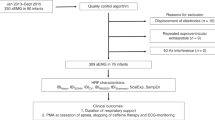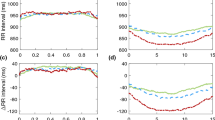Abstract
OBJECTIVE: To evaluate the dynamic RT (QRS apex-end of T wave) rate dependence in newborns.
STUDY DESIGN: A Digital Holter ECG was acquired on day 15 in nine full-term and eight preterm infants. Ten-minute periods were recorded during wakefulness and sleep. The accuracy of fit with RT–RR pairs was individually assessed by 14 regression formulas (r coefficient, Akaike score, residual analysis). The medians of RT and Bazett's RT correction were calculated for each 10 milliseconds of RR.
RESULTS: The mean RR and RT were 429±51 and 263±18 milliseconds. None of the prediction formulas were sufficiently accurate to describe RT over the whole range of RR (r<0.56). The Bazett correction produced differences of more than 50 milliseconds at different RR. Prematurity, sleep state and heart rate variability did not influence RT–RR relation.
CONCLUSION: None of the parametric formulas were found to be accurate in describing RT rate dependence in newborns.
This is a preview of subscription content, access via your institution
Access options
Subscribe to this journal
Receive 12 print issues and online access
$259.00 per year
only $21.58 per issue
Buy this article
- Purchase on Springer Link
- Instant access to full article PDF
Prices may be subject to local taxes which are calculated during checkout




Similar content being viewed by others
References
Bazett H . Analysis of the time relations of electrocardiograms. Heart 1920;7:353–370.
Seed WA, Noble MI, Oldershaw P, Wanless RB, Drake-Holland AJ, Redwood D, et al. Relation of human cardiac action potential duration to the interval between beats: Implications for the validity of rate corrected QT interval (QTc). Br Heart J 1987;57:32–37.
Sagie A, Larson MG, Goldberg RJ, Bengtson JR, Levy D . An improved method for adjusting the QT interval for heart rate (the Framingham Heart Study) [see comments]. Am J Cardiol 1992;70:797–801.
Karjalainen J, Viitasalo M, Manttari M, Manninen V . Relation between QT intervals and heart rates from 40 to 120 beats/min in rest electrocardiograms of men and a simple method to adjust QT interval values [see comments]. J Am Coll Cardiol 1994;23:1547–1553.
Sarma JS, Venkataraman K, Samant DR, Gadgil UG . Effect of propranolol on the QT intervals of normal individuals during exercise: a new method for studying interventions. Br Heart J 1988;60:434–439.
Sarma JS, Singh N, Schoenbaum MP, Venkataraman K, Singh BN . Circadian and power spectral changes of RR and QT intervals during treatment of patients with angina pectoris with nadolol providing evidence for differential autonomic modulation of heart rate and ventricular repolarization. Am J Cardiol 1994;74:131–136.
Cappato R, Alboni P, Pedroni P, Gilli G, Antonioli GE . Sympathetic and vagal influences on rate-dependent changes of QT interval in healthy subjects. Am J Cardiol 1991;68:1188–1193.
Morganroth J, Brozovich FV, McDonald JT, Jacobs RA . Variability of the QT measurement in healthy men, with implications for selection of an abnormal QT value to predict drug toxicity and proarrhythmia. Am J Cardiol 1991;67:774–776.
Rautaharju PM, Warren JW, Calhoun HP . Estimation of QT prolongation. A persistent, avoidable error in computer electrocardiography. J Electrocardiol 1990;23:111–117.
Perticone F, Ceravolo R, Maio R, Cosco C, Mattioli PL . Heart rate variability and sudden infant death syndrome. Pacing Clin Electrophysiol 1990;13:2096–2099.
Schwartz PJ, Montemerlo M, Facchini M, Salice P, Rosti D, Poggio G, et al. The QT interval throughout the first 6 months of life: a prospective study. Circulation 1982;66:496–501.
Horigome H, Takahashi MI, Asaka M, Shigemitsu S, Kandori A, Tsukada K . Magnetocardiographic determination of the developmental changes in PQ, QRS and QT intervals in the foetus. Acta Paediatr 2000;89:64–67.
Villain E, Levy M, Kachaner J, Garson A Jr . Prolonged QT interval in neonates: Benign, transient, or prolonged risk of sudden death. Am Heart J 1992;124:194–197.
Perticone F, Ceravolo R, Mattioli PL . Prolonged QT interval: A marker of sudden infant death syndrome? Clin Cardiol 1991;14:417–421.
Southall DP, Arrowsmith WA, Stebbens V, Alexander JR . QT interval measurements before sudden infant death syndrome. Arch Dis Child 1986;61:327–333.
Schaffer MS, Trippel DL, Buckles DS, Young RH, Dolan PL, Gillette PC . The longitudinal time course of QTc in early infancy. Preliminary results of a prospective sudden infant death syndrome surveillance program. J Perinatol 1991;11:57–62.
Schwartz PJ, Stramba-Badiale M, Segantini A, et al. Prolongation of the QT interval and the sudden infant death syndrome [see comments]. N Engl J Med 1998;338:1709–1714.
Kawataki M, Kashima T, Toda H, Tanaka H . Relation between QT interval and heart rate. Applications and limitations of Bazett's formula. J Electrocardiol 1984;17:371–375.
Fridericia LS . Die Systolendauer im Elektrokardiogramm bei normalen Menschen und bei Herzkranken. Acta Med Scand 1920;53:469–486.
Adams W . The normal duration of the electrocardiographic ventricular complex. J Clin Invest 1936;15:335–342.
Ashman R . Normal duration of QT interval. Am Heart J 1942;23:522–534.
Carmeliet E . Influence du rythme sur la durée du potentiel d’action cardiaque. Arch Int Physiol Biochim 1955;63:222–232.
Sarma JS, Sarma RJ, Bilitch M, Katz D, Song SL . An exponential formula for heart rate dependence of QT interval during exercise and cardiac pacing in humans: Reevaluation of Bazett's formula. Am J Cardiol 1984;54:103–108.
Funck-Brentano C, Jaillon P . Rate-corrected QT interval: Techniques and limitations. Am J Cardiol 1993;72:17B–22B.
Govreen-Segal D, Radai MM, Sivan Y, Abboud S . Real-time PC-based system for dynamic beat-to-beat QT – RR analysis. Comput Biomed Res 1999;32:336–354.
Sadeh D, Shannon DC, Abboud S, Saul JP, Akselrod S, Cohen RJ . Altered cardiac repolarization in some victims of sudden infant death syndrome. N Engl J Med 1987;317:1501–1505.
Pladys P, Maison-Blanche P, Gout B, Badilini F, Bril A, Carre F . Influence of sympathetic heart rate modulation on RT interval rate adaptation in conscious dogs. Pacing Clin Electrophysiol 2000;23:1604–1610.
Nelson N, Illes L . The Q – oTc and Q – Tc interval and ionized calcium in newborns. Clin Physiol 1989;9:39–45.
Escabias MI, Santisteban R, Rubio MD, Tovar P . Relationship between plasmatic concentrations of K, Na and Ca, and ECG from foals during postnatal phase. Nippon Juigaku Zasshi 1990;52:257–263.
Badilini F, Maison-Blanche P, Childers R, Coumel P . QT interval analysis on ambulatory electrocardiogram recordings: A selective beat averaging approach. Med Biol Eng Comput 1999;37:71–79.
Garson AJ . Diagnostic electrocardiography. In: Anderson RH, Baker EJ, Macartney RFJ, Rigby ML, Shinebourn EA, Tynan A, editors. Paediatric Cardiology. 2nd edn. Vol. I. London: Harcourt Publishers; 2002. p. 307–308.
Eckberg DL . Sympathovagal balance. A critical appraisal. Circulation 1997;96:3224–3232.
Matsunaga T, Mitsui T, Harada T, Inokuma M, Murano H, Shibutani Y . QT corrected for heart rate and relation between QT and RR intervals in beagle dogs. J Pharmacol Toxicol Methods 1997;38:201–209.
Matthews JNS, Altman DG, Campbell MJ, Royston P . Analysis of serial measurements in medical research. BMJ 1990;300:230–235.
Molnar J, Weiss J, Zhang F, Rosenthal JE . Evaluation of five QT correction formulas using a software-assisted method of continuous QT measurement from 24-hour Holter recordings. Am J Cardiol 1996;78:920–926.
Hnatkova K, Malik M . "Optimum" formulae for heart rate correction of the QT interval. Pacing Clin Electrophysiol 1999;22:1683–1687.
Rautaharju PM, Zhou SH, Wong S, Calhoun HP, Berenson GS, Prineas R, et al. Sex differences in the evolution of the electrocardiographic QT interval with age. Can J Cardiol 1992;8:690–695.
Molnar J, Zhang F, Weiss J, Ehlert FA, Rosenthal JE . Diurnal pattern of QTc interval: How long is prolonged? Possible relation to circadian triggers of cardiovascular events [see comments]. J Am Coll Cardiol 1996;27:76–83.
Murakawa Y, Inoue H, Nozaki A, Sugimoto T . Role of sympathovagal interaction in diurnal variation of QT interval. Am J Cardiol 1992;69:339–343.
Vialle E, Albalkhi R, Zimmerman M, Friedli B . Normal values of signal-averaged electrocardiographic parameters and QT dispersion in infants and children. Cardiol Young 1999;9:556–561.
Macfarlane PW, McLaughlin SC, Devine B, Yang TF . Effects of age, sex, and race on ECG interval measurements. J Electrocardiol 1994;27:14–19.
Lande G, Funck-Brentano C, Ghadanfar M, Escande D . Steady-state versus non-steady-state QT – RR relationships in 24-hour Holter recordings. Pacing Clin Electrophysiol 2000;23:293–302.
Author information
Authors and Affiliations
Additional information
This study was supported by “Naître et vivre” and by COREC and presented in part at the meeting of the American Academy of Pediatrics, San Francisco, CA, October 2001 (Pediatric Cardiology 2001;22:450–451).
Rights and permissions
About this article
Cite this article
Pladys, P., Senhadji, L., Blanche, P. et al. Beat-to-beat Analysis of the Relation between RT and RR Intervals in Newborns. J Perinatol 23, 212–217 (2003). https://doi.org/10.1038/sj.jp.7210890
Published:
Issue Date:
DOI: https://doi.org/10.1038/sj.jp.7210890



